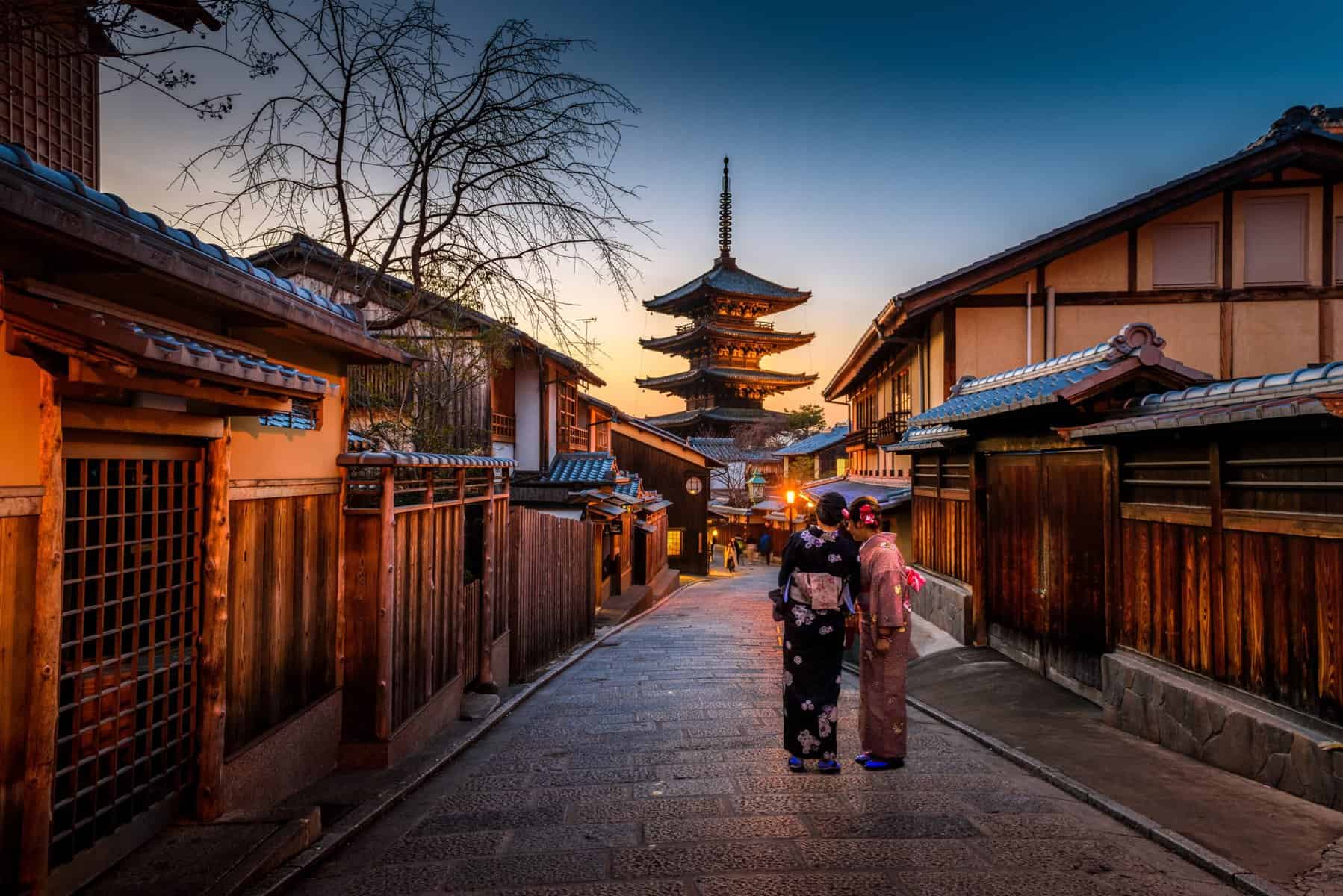
Best Things To Do In Kyoto – Japan’s Cultural Capital
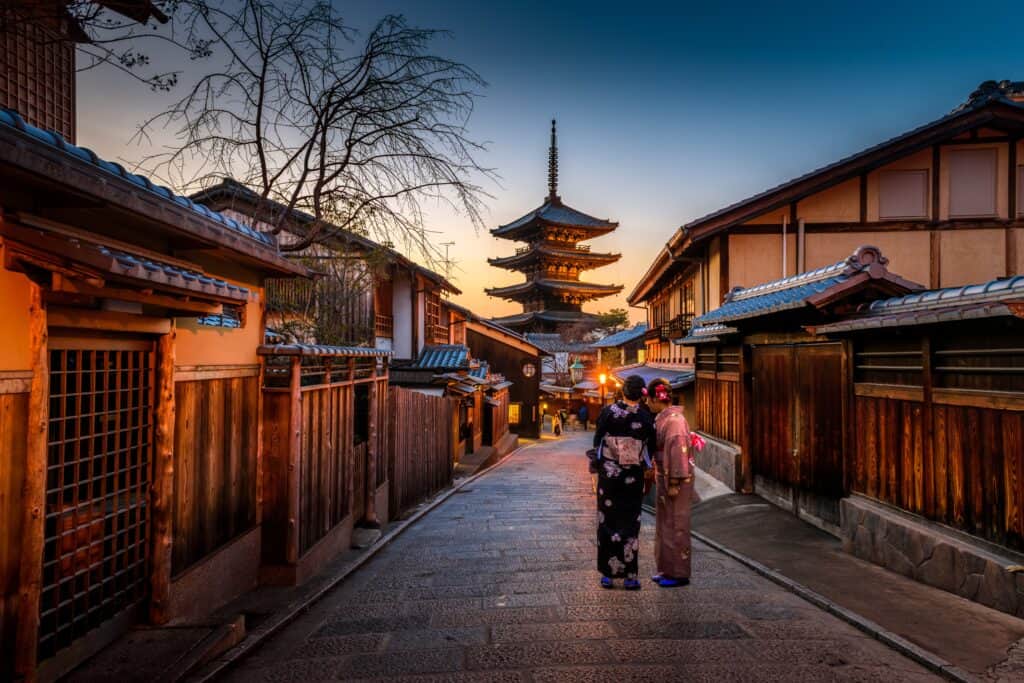
Kyoto served as a capital city of Japan for more than a thousand years and it remains one of the country’s most important cultural centres. With over 1,600 Buddhist temples, 400 Shinto shrines and 17 UNESCO World Heritage sites, the city is brimming with history and tradition.
Whether you are visiting Kyoto for the first time or have visited before, discovering the old capital’s rich history and hidden gems is always an enlightening experience.
With so many things to do here, we have selected the best things to do to in Kyoto to give you the best insight into Japan’s cultural capital. So let’s get started.
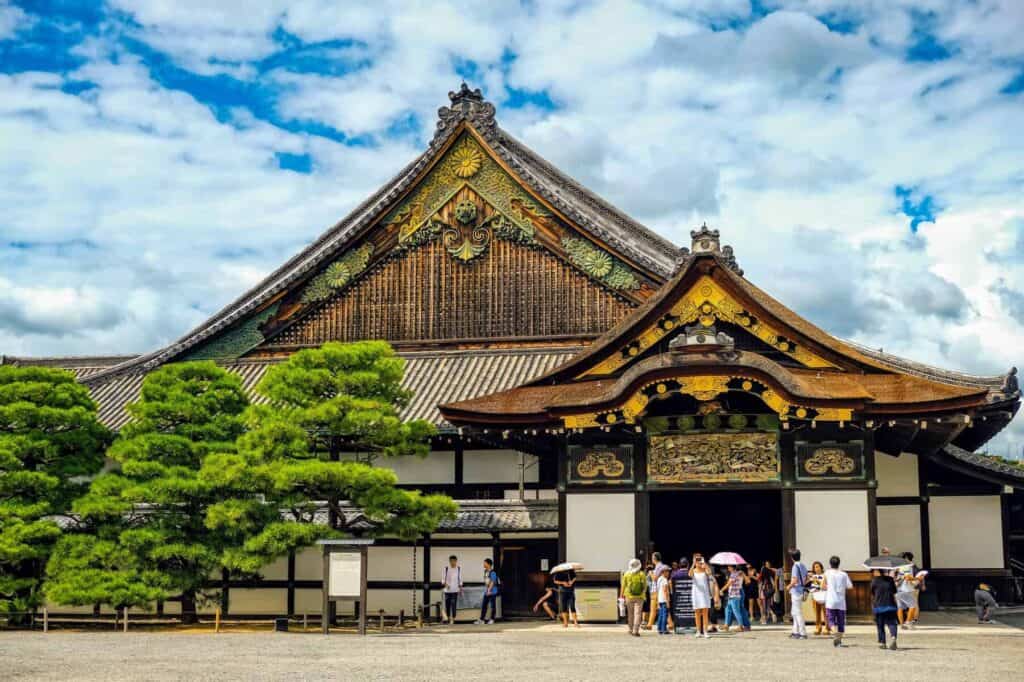
Nijo Castle
Nijo castle was built in 1603 and served as the residence of the Tokugawa Leyasu shogunate dynasty, who ruled Japan during the Edo period. After the shogunate fell, the castle became an imperial palace and then was donated to the city and opened to the public.
Now a UNESCO world heritage site and one of the very few remaining castles from the Edo period, Nijo Castle is a must visit destination.
This castle is mainly on one level and consists of six connected buildings surrounded by stone walls and a moat.
When you come into the castle grounds, the first thing you will see is the Karamon, an impressive gate with a curved gable called karahafu, which is unique to Japan.
Once inside the main building, you can walk through a number of impressive audience halls and living quarters. Each room is decorated elaborately with carvings and wall paintings all symbolic and showing the power of the Shogunate during the Edo period.
One of the most interesting features of this castle is the nightingale floors that make a sound when walked upon. This was an ancient security system to catch any intruders entering the castle at night.
Outside, the gardens are just as impressive and famous in their own right as they were designed by a Kobori Enshu who was a notable artist and aristocrat during Tokugawa Leyasu’s reign.
The site is open daily from 8:45am-4pm. Closed during public holidays. Entrance tickets can be purchased at the main gate along with audio guides.

Kinkakuji (Golden Pavilion)
Kinkakuji or the Golden Pavilion is a must-see for any visitor to Kyoto. This 3-storey building decorated in golden leaf stands out amongst its lush natural surroundings and reflects perfectly into the pristine pond in front of the building.
Another of the city’s UNESCO world heritage sites, this building dates back to the 14th century and was the retirement villa for Ashikaga Yoshimitsu; a shogun military commander and an important patron of arts. After Yoshimitsu’s death, the pavilion was converted into a zen temple.
This pavilion has had to be rebuilt several times as it has been destroyed by fires over the centuries and the current replica was built in 1955.
Once inside the grounds, you can walk around the pavilion and marvel as its sheer beauty. There are also several traditional gardens as well as a traditional tea house located within the temple grounds.
To avoid crowds, it is best to visit Kinkakuji early in the morning or later in the afternoon. Additionally, visiting the temple in the spring and autumn/fall will provide even more breathtaking views of the temple and its surrounding gardens.
Kinkakuji is a great place to visit for anyone looking to explore the beauty of Japanese architecture and nature working together.
The site is open daily from 9am-5pm. Entrance tickets can be purchased at the main gate.
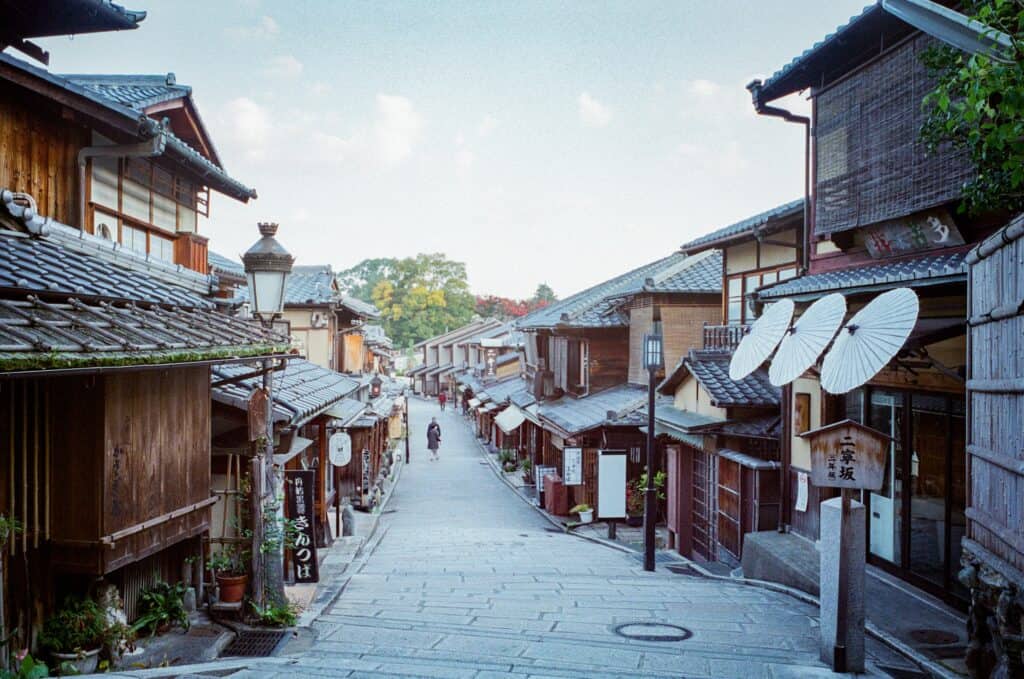
Higashiyama District
This beautiful historical district is roughly bounded by the Kamo River to the west and Higashiyama mountain range to the east. Higashiyama district is known for its traditional Japanese architecture, winding streets, wooden houses and temples, and offer all who visit a glimpse into Japan’s ancient past.
The district features many of the city’s key attractions, including Kiyomizu-dera Temple, Yasaka Pagoda (Hokan-ji Temple) and Gion; the famous geisha and entertainment quarter.

Kiyomizu-dera Temple
Kiyomizu-dera is one of Japan’s most famous temples with over 1,200 years of history. Also known as the Temple of Pure Water Spring, this temple has many impressive features, including the stunning red Noimon Gate, a striking three storey pagoda and the temple’s main hall – which has a wooden verandah which hangs over the cliff with impressive views of Kyoto. This veranda has been constructed without using a single nail – a technique called kake-zukuri.
Below this veranda is the Otowa Waterfall where you can drink the waters for health and longevity. As this temple is one of the most famous and scenic temples in Japan (and a UNESCO world heritage site) try and get here early.
This temple opens daily from 6am-6pm and tickets can be purchased at the booth at the base of the temple.
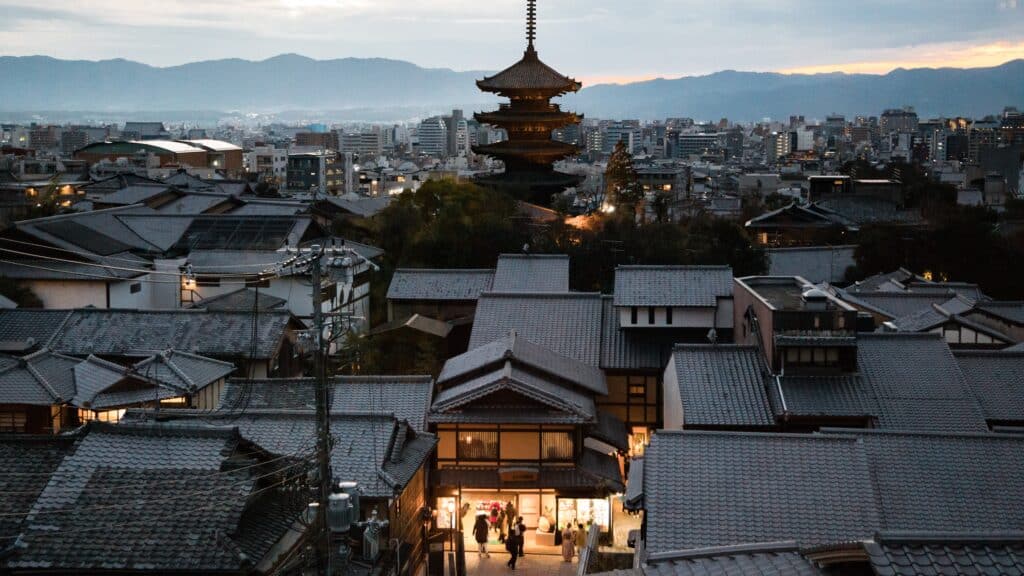
Yasaka Pagoda
One of the districts most prominent landmarks is the five storey Yasaka Pagoda; the oldest pagoda in Kyoto. Originally part of the Hokan-ji temple complex, the pagoda is the only part that has survived over the years. Towering over the ancient streets at a height of 46m, this place is a must visit.
It is possible to go inside the pagoda, however opening times are irregular and the pagoda is often closed. If the pagoda is open, the hours are generally 9am-3pm.
The best times to visit and take beautiful photographs of the Pagoda without the crowds is during the early hours of the morning or early evening when the temple is lit up.
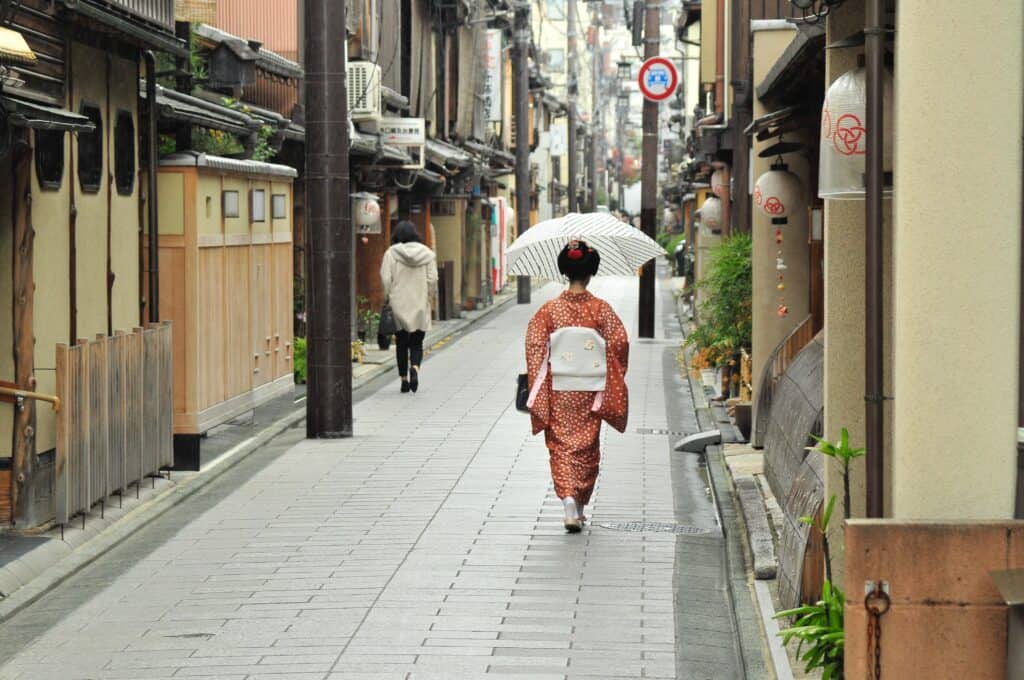
Gion
Gion is Kyoto’s most famous geisha and entertainment quarter. The area developed in the 18th century through its popularity of teas houses and geisha culture.
The area is full of landmarks and include Yasaka Shrine, Gion Corner, Poncho Alley, Tea Houses and Theatres.
Yasaka Shrine
This historic Shinto shrine, nestled in the heart of Kyoto’s famous Gion district dates from 1654. Once inside the complex you can visit a number of smaller shrines and the impressive main hall, decorated with lanterns.
This shrine is best know for hosting one of the country’s most famous and vibrant festivals; the Gion Matsuri. This grand festival, held annually in July, dates back to the 9th century and features a dazzling series of events, including a procession of elaborate floats, traditional music, and dancing.
The shrine is open 24 hours and free to enter and it is also worth visiting at night as the shine is lit up.
Gion Corner
Gion Corner stands out as a must-do for anyone seeking to immerse themselves in traditional Japanese arts and entertainment.
Gion Corner, located in Yasaka Hall, was designed as a showcase for traditional Japanese performing arts, providing all who visit a convenient and accessible venue to experience these time-honoured art forms. The theatre has a seating capacity of around 200, ensuring that every audience member enjoys an up-close and personal encounter with the performers.
Gion Corner’s nightly performances include a diverse range of traditional arts, such as:
- Kyogen: A form of classical Japanese comic theater, featuring humorous stories and slapstick comedy.
- Kyomai: An elegant and refined style of dance originating in Kyoto, often performed by geiko (geisha) and maiko (apprentice geisha).
- Gagaku: Ancient Japanese court music, characterized by its slow, ethereal melodies.
- Bunraku: Traditional Japanese puppet theater, where intricate, life-sized puppets are skillfully manipulated by a team of puppeteers.
- Koto: A mesmerizing performance on the koto, a traditional Japanese stringed instrument.
- Ikebana: The delicate art of Japanese flower arrangement, showcasing the beauty and harmony of nature.
- Tea ceremony: A demonstration of the revered Japanese tea ceremony, highlighting the principles of harmony, respect, purity, and tranquility.
For Information on the the venue and and tickets, visit the Gion Corner website.
Poncho Alley
The Poncho Alley is another popular destination in Gion. Poncho Alley (also known as Pontocho Alley), is a narrow, atmospheric street located parallel to the Kamogawa River. This charming alley is a haven for food lovers and shoppers.
The alley’s name, “Pontocho,” is said to be derived from the Portuguese word “ponto,” meaning “bridge” or “tip,” and the Japanese word “cho,” which refers to a town or district.
As you stroll down Poncho Alley, you’ll be captivated by the charming atmosphere created by the traditional wooden machiya buildings, which house a different establishments, from izakayas and teahouses to high-end kaiseki restaurants and lively bars. The alley truly comes alive at night, with lanterns casting a warm glow over the bustling street.
Poncho Alley is a paradise for food enthusiasts. Whether you’re craving a casual meal at a local izakaya, where you can sample a variety of small dishes and snacks while sipping on sake or beer, or you’re in the mood for a more formal kaiseki dining experience, where beautifully presented, multi-course meals showcase the finest Japanese ingredients.
One of the unique features on the west of Poncho Alley is the riverside dining terraces, known as “kawayuka” or “yuka.” During the warmer months, these outdoor platforms provide diners with a picturesque view of the Kamogawa River, creating an unforgettable dining experience. Be sure to make reservations in advance if you wish to secure a spot on one of these coveted terraces.
In addition to its culinary offerings, Poncho Alley also boasts a variety of shops selling traditional Japanese crafts, souvenirs, and clothing. As you explore the alley, be on the lookout for unique items such as handmade pottery, delicate fans, and exquisite kimonos.
Geisha Culture
Gion, Kyoto’s most famous geisha quarter is steeped in history and tradition. This charming neighbourhood offers a fascinating glimpse into the world of the geisha.
Geisha have been an integral part of Japanese culture and the Gion became associated with geisha culture due to its numerous teahouses (ochaya) and entertainment establishments that catered to the city’s elite. Over time, Gion emerged as one of Japan’s most prestigious geisha districts, attracting talented performers and artisans from across the country.
In Kyoto, geisha are referred to as geiko, while their apprentices are called maiko. Maikos undergo a period of training that usually lasts around five years, during which they master various traditional arts such as dance, music (particularly the shamisen, a three-stringed instrument), tea ceremony, and conversation. Once a maiko has demonstrated her proficiency in these arts, she undergoes an important ceremony called erikae, marking her transition from maiko to geiko.
If you are interested in experiencing the geisha culture, these are the best ways to do so.
Ochaya Evenings: Traditional geisha entertainment takes place in exclusive teahouses known as ochaya. These intimate, invite-only establishments typically cater to wealthy clientele and require a personal introduction from an existing patron. However, hotels and tour companies offer ochaya experiences for tourists, where you can enjoy a private evening of geisha entertainment, including dance performances, music, and engaging conversation.
Geisha Performances: A number of theatres in the Gion host regular performances that showcase geisha dances and music. This includes Gion Corner.
Geisha Spotting: As you stroll through Gion’s atmospheric streets, particularly around dusk, you may catch a glimpse of geiko or maiko on their way to evening engagements. While it’s essential to be respectful and maintain a polite distance, observing these elegant women in their traditional attire is a memorable experience.
Geisha Makeover Experiences: Several studios in Gion offer visitors the chance to experience the world of geisha firsthand by dressing up in traditional maiko attire, complete with makeup and hairstyle. These makeover experiences often include a professional photoshoot as a unique souvenir of your time in Kyoto.
Tea Houses
A trip to Kyoto’s historic Gion district is incomplete without experiencing the charm and allure of its traditional tea houses. These establishments, known as ochaya, have long been a cornerstone of Japanese culture, offering guests an intimate setting in while savouring tea and delicacies. The following are some of the tea houses that are open to tourists.
Kagizen Yoshifusa: Is a renowned tea house and sweet shop specializing in traditional Japanese confectionery. The tea house’s elegant interior features beautiful artwork, adding to the overall sensory experience.
Gion Tsujiri: This popular tea house and sweet shop serves high-quality tea and confectionery.
Camellia Tea Ceremony: If you are interested in experiencing a traditional Japanese tea ceremony, Camellia Tea Ceremony is a must-visit establishment. Located in a restored machiya (traditional wooden townhouse), this tea house offers guests the opportunity to participate in an authentic tea ceremony led by skilled tea masters. Here you can learn about the history and significance of the tea ceremony while enjoying a bowl of matcha tea and a selection of sweets.
Kabuki Theatre
Gion also offers visitors the opportunity to experience the captivating art of going to kabuki theatre and located in Gion is the Minamiza Theatre, one of the most famous kabuki theatres in Japan.
Kabuki is a classical form of Japanese theatre which dates back to the early 1600s, featuring historically-based stories with characters from literature, mythology, and history. Actors use exaggerated makeup styles, elaborate costumes, and intricate dance movements to bring the stories to life.
Attending a kabuki performance at the Minamiza Theatre in Gion is truly a once-in-a-lifetime cultural experience that offers a unique and fascinating insight into Japan’s rich theatre heritage.
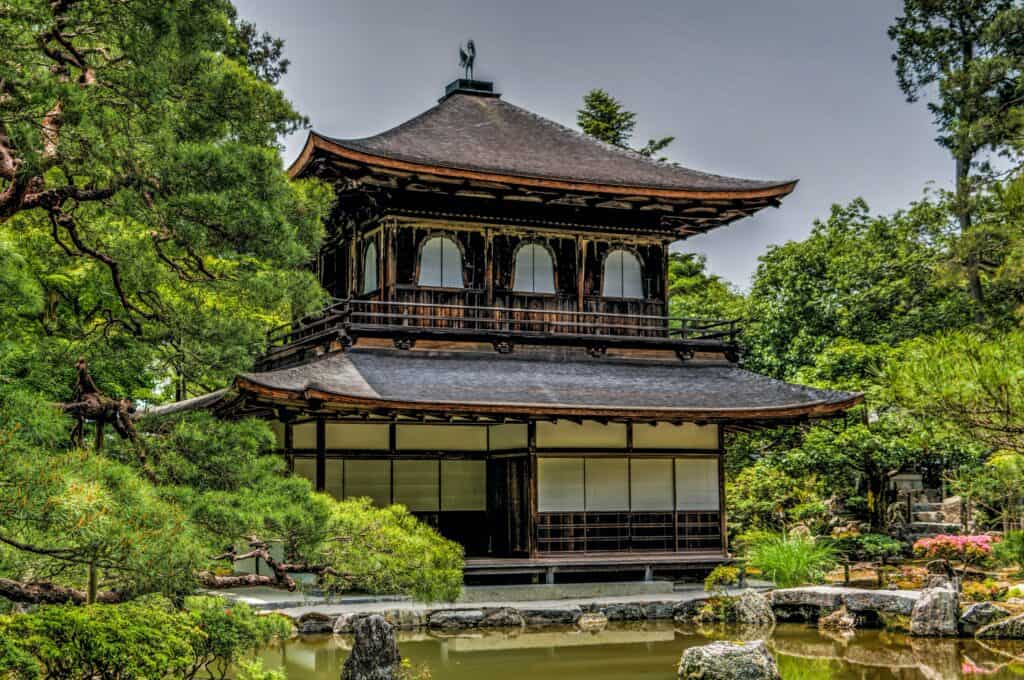
Ginkakuji Temple
This zen temple is also known as the Silver Pavilion (but was never coated in silver) was once the retirement villa of an art obsessed shogun Ashikaga Yoshimasa and modelled after the Kinkakuji Temple (Golden Pavilion). This temple complex is made up of the the Silver Pavilion building as well as a number of other buildings/shrines and set in beautiful gardens spread over two levels. This temple is also a UNESCO world heritage site so again try and visit early or late when it is less crowded.
Ginkakuji is open daily from 8:30 am to 5:00 pm (last entry at 4:30 pm).

Nishiki Market
Nishiki Market is a must visit destination for food and shopping enthusiasts.
Also known as “Kyoto’s Kitchen,” this market has been operating for over 300 years. The market is under a long covered arcade, with over 100 stalls, and is really easy to navigate. Each stall showcases the best of Japanese food and produce and offer everything from fresh food, fish, seafood, dried goods, traditional crafts, and souvenirs.
This is a great place for foodies and photographers or anyone who just wants an insight into Japan’s incredible food culture.
You will be spoilt for choice with such an abundance of options to choose from. Food lovers will enjoy trying the market’s specialties, such as tsukemono (pickled vegetables), senbei (Japanese rice crackers), and mochi (Japanese rice cake). Fresh seafood and fish, including sashimi are also available for purchase. Meanwhile, the craft section offers traditional items such as calligraphy brushes, pottery, fans and silk handicrafts that make great souvenirs.
This market opens at 9am so unlike other markets you don’t need to go early however, if possible try and avoid lunchtimes.
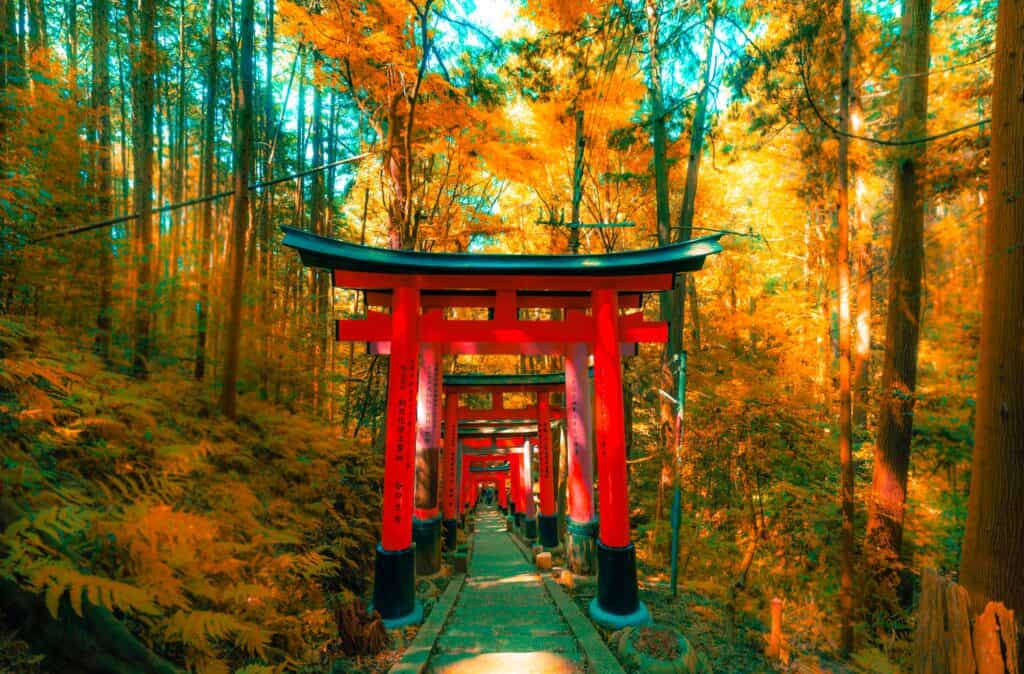
Fushimi Inari-Taisha Shrine
Fushimi Inari-Taisha Shrine is one of Kyoto’s most treasured and unique cultural landmarks.
This shrine was constructed in the 8th century on the base of Mount Inari and dedicated to the Inari, god of rice and saki. Visitors come here to make wishes for wealth, prosperity and business success.
Behind the shrine is the most impressive series of torii gates (hundreds) that forms a trail to the top of Mount Inari.
Allow 2-3 hours to complete the light trek to the top, however there are several stops along the way which give you great views of the city and allows you to easily turn back and go back down.
The site is free to enter and accessible 24 hours a day. However, it is recommended to visit either early in the morning or later in the evening to avoid the crowds.
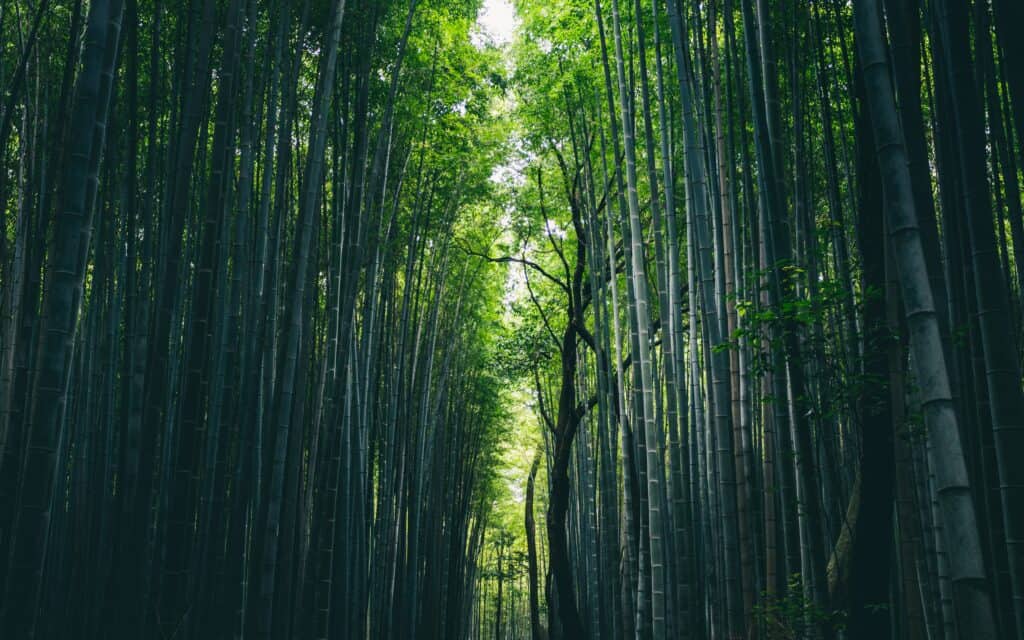
Arashiyama Bamboo Forest
The Arashiyama Bamboo Forest in Kyoto is another great Kyoto experience. The forest is filled with towering bamboo stalks that form a natural canopy, creating a serene and peaceful atmosphere as you walk through the guided path. The unique beauty and photo opportunities are unparalleled and will leave you feeling rejuvenated.
As the bamboo forest is open all day so try and visit early in the morning to make the experience truly serene and catch the morning light.

Philosopher’s Path
A wonderful way to enjoy Kyoto’s rich spiritual culture is to walk the Philosopher’s path. This walk along a canal is so named because the Japanese philosopher Nishida Kitaro meditated on this path during his daily commute to Kyoto university.
This path (around 2 km) takes you past temples, shrines and cafes. This path is considered a spiritual and cultural experience and of course to get the most of this contemplative stroll try and do this as early or late as possible (as it is now so popular) and it is even more popular during the cherry blossom season.
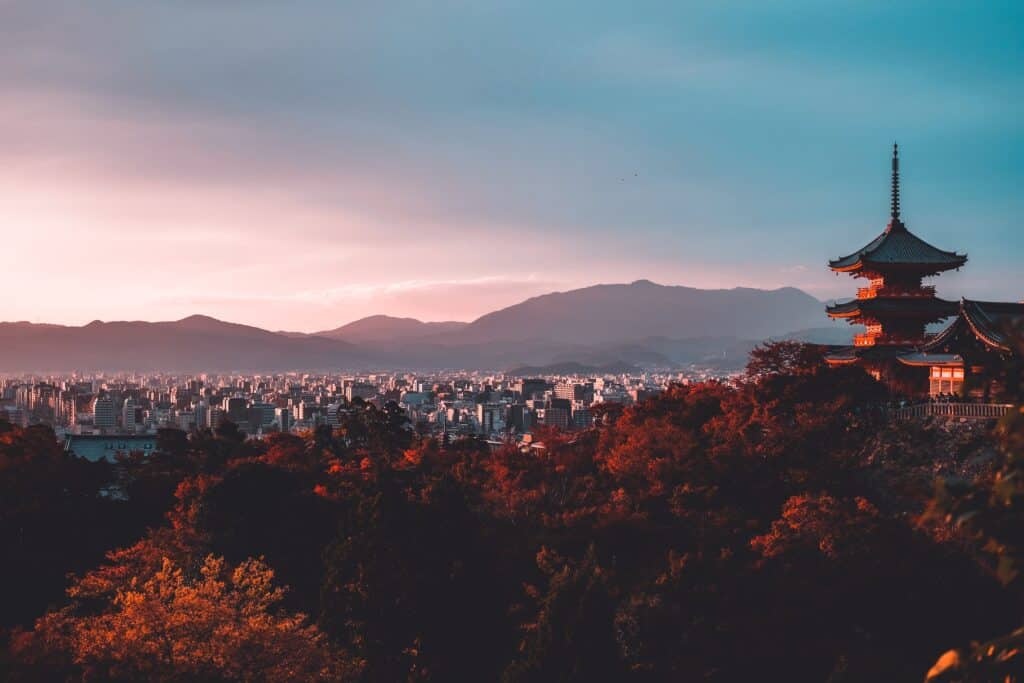
So to wrap on the Best Things To Do In Kyoto
Nowhere in Japan will you find such a concentration of historic sites than Kyoto – it really is the heart of Japanese culture. We have given you the best selection of things to do that will leave you in awe and wanting to come back.
We hope this list of the best things shows you why Kyoto has been admired for centuries. Take it from us – Kyoto should definitely be on your list of places to visit!
Further FAQs
When is the Best Time to Visit Kyoto?
The most popular and recommended times to visit Kyoto are during the spring and autumn/fall seasons.
Spring (March to May) is the most popular season due to the beautiful cherry blossoms (sakura) that bloom across the city. The peak bloom period typically occurs around late March to early April, although this can vary slightly each year. The weather during spring is generally mild and pleasant, with daytime temperatures ranging from 50°F to 70°F (10°C to 21°C). Spring is an excellent time for sightseeing, outdoor activities, and experiencing traditional Japanese events like hanami (cherry blossom viewing) parties.
Autumn/Fall (October to November) is another popular time to visit Kyoto, as the city’s foliage transforms into vibrant shades of red, orange, and yellow. The peak autumn/fall foliage usually occurs around October to mid-November, offering stunning views at temples, shrines, and parks throughout the city. The weather during autumn/fall is similar to spring, with comfortable temperatures and relatively low rainfall.
Summer (June to September) is less popular due to the hot and humid weather, with temperatures often exceeding 86°F (30°C). Additionally, June can be rainy, making outdoor activities less enjoyable. However, if you don’t mind the heat and humidity, summer offers several unique festivals and events, such as the famous Gion Matsuri in July.
Winter (December to February) in Kyoto is cold, with temperatures ranging from 32°F to 45°F (0°C to 7°C). While the city doesn’t receive much snowfall, the occasional dusting of snow can create a magical atmosphere at temples and shrines. Winter is also the least crowded season, making it an excellent time for those who prefer to avoid crowds and enjoy lower accommodation rates.
Which Airports Serve Kyoto?
Kyoto does not have its own airport. However, it is conveniently served by two nearby airports.
Kansai International Airport (KIX): Located approximately 50 miles (80 km) in the Osaka Prefecture, Kansai International Airport is the primary international gateway for the Kansai region, which includes Kyoto, Osaka, and Kobe. The airport offers numerous international and domestic flights, making it the most convenient option for travellers coming from overseas. To reach Kyoto from Kansai International Airport, you can take the express train, which takes about 75 minutes, or use other options like airport taxis and buses.
Itami Airport (ITM): Also known as Osaka International Airport, Itami Airport is situated about 25 miles (40 km) southeast of Kyoto. It primarily serves domestic flights within Japan, with a few short-haul international flights to nearby Asian destinations. To get to Kyoto from Itami Airport, you can take a combination of monorail and train, which takes about an hour, or use the airport bus service. Taxi options are also available.
Taipei and the north experience some 95 inches of rainfall yearly, reaching a peak in the summer months between June to September.
What Local Transport Options Are Available?
Kyoto has a number of great local transport options for getting around the city.
The Kyoto Subway system: Known for its cleanliness, punctuality, and ease of use; the subway is the most convenient way of getting around the city. The stations and trains are well-maintained, and signs are available in English making it tourist-friendly.
Taxis: Are readily available in Kyoto, but they can be expensive for longer distances. They are a good option if you’re travelling with heavy luggage or need to get somewhere quickly or travelling late at night.
Buses: Cover almost the whole city but are not as convenient compared to the subway system.
Where to Stay?
There are many districts in the city that offer great accommodation options. These are the best districts to stay in Kyoto.
Higashiyama District: Located in eastern Kyoto, is one of the city’s most scenic and historic areas. This district is home to many iconic attractions, such as Kiyomizu-dera Temple, Yasaka Shrine, and the historic streets of Gion (the famous geisha district). Staying in Higashiyama allows you to fully immerse yourself in Kyoto’s traditional atmosphere, with easy access to numerous temples, shrines, and shops and restaurants.
Downtown Kyoto (Karasuma & Shijo): Downtown Kyoto, is the city’s business and shopping hub. This area offers a wide range of accommodations, from luxury hotels to budget guesthouses. Staying in downtown Kyoto provides easy access to the subway making it convenient for exploring all parts of the city. The area also boasts numerous dining and entertainment options, as well as a lively nightlife scene.
Kyoto Station Area: The area surrounding Kyoto Station is ideal for travellers who prioritise convenience and accessibility. As the city’s main transportation hub, staying near Kyoto Station allows for easy connections to other parts of Kyoto, as well as neighbouring cities like Osaka and Nara. This area offers a wide range of accommodations, from luxury hotels to affordable hostels. It also has numerous dining options, shopping malls, and entertainment venues.
Arashiyama District: Located in the western part of Kyoto, Arashiyama is known for its stunning natural beauty and serene atmosphere. Famous attractions in this area include the bamboo groves, Tenryu-ji Temple, and the Togetsukyo Bridge. Arashiyama offers a more relaxed and peaceful experience compared to the bustling city centre, with accommodations ranging from ryokans (traditional Japanese inns) to boutique hotels.
For some great Hotel Hacks, read our Best Hotel Hacks blog post.
https://inspiredtravelhacks.com/best-hotel-hacks-that-every-traveller-should-know/
Is Kyoto Safe?
Kyoto is widely considered a safe city to visit, boasting low crime rates and a welcoming atmosphere for travellers. Like the rest of Japan, Kyoto enjoys a reputation for its safety, cleanliness, and well-maintained public spaces.
As with any travel destination, it’s always essential to exercise common sense and take basic precautions to ensure your safety, such as being aware of your surroundings, not displaying valuable items openly, and avoiding poorly lit or deserted areas at night.
Read our 35 Most Important Travel Safety Tips You Should Know for great advise on all things travel safety.

